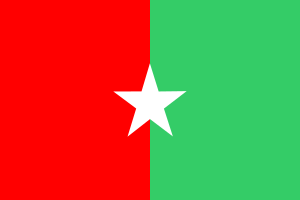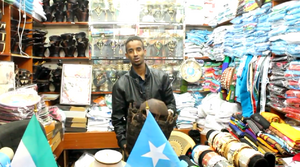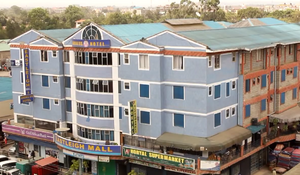الصوماليون في كينيا
 | |
| إجمالي التعداد | |
|---|---|
| 2,780,502 (2019 census)[1][2] | |
| المناطق ذات التجمعات المعتبرة | |
| North Eastern Province • Nairobi • Mombasa | |
| اللغات | |
| Somali (mother tongue) English, Swahili (working languages) | |
| الدين | |
| Sunni Islam |
| جزء من سلسلة عن |
| ثقافة كينيا |
|---|
 |
|
|
الصوماليون في كينيا هم المواطنون والمقيمون في كينيا ويوعد أصلهم للعرق الصومالي. واستقروا تاريخياً المقاطعة الشمالية الشرقية، والتي كانت تسمى سابقاً منطقة الحدود الشمالية، والتي تم اقتطاعها من منطقة جوبالاند في جنوب الصومال الحالية خلال الفترة الاستعمارية. وفي أعقاب الحرب الأهلية في الصومال التي اندلعت في عام 1991، طلب العديد من الصوماليين اللجوء في كينيا بالمناطق المأهولة بالصوماليين. وأسسوا أنفسهم في قطاع الأعمال، لا سيما في ضاحية نيروبي في إيستلي.
عدد السكان
بحسب التعداد السكاني لعام 2019 في كينيا، يعيش حوالي 2,780,502 من أصل في كينيا.[1] منهم 300.000 لاجئ.[3] وهم مختلفون عن البانتوس والأقليات الأخرى في الصومال، والذين يشكلون وفقاً لـالوكالة الأمريكية للتنمية الدولية معظم اللاجئين الصوماليين في كينيا.[4]
التاريخ
Somalis in Kenya, being Eastern Cushites, formed one of the last waves of migrations into present-day Kenya. The current Somali clans started moving into what is today North Eastern Kenya after the Oromo(Galla) were dislodged from the Juba Valley and mostly moved to the Ethiopian Highlands in the 16th Century, leaving much of Southern Somalia and North Eastern Kenya open to Somali migrationThe Origins of the Galla and Somali. Further movement of Somalis into Kenya took place under the British,who transferred some clans like the Degodia and some Ogadeni sub-clans to Wajir district to graze alongside the long established Ajuran clanColonial Policies and the Failure of Somali Secessionism in the Northern Frontier Dustrict of the Kenya Colony. As such, They have historically inhabited the North Eastern Province, previously a part of the Northern Frontier District (NFD) which also included the present day Borana and Gabra inhabited Marsabit and Isiolo Counties. The NFD came into being in 1925, when it was carved out of the Somalia.[5] At the time under British colonial administration, the northern half of Jubaland was ceded to Italy as a reward for the Italians' support of the Allies during World War I.[6] Britain retained control of the southern half of the territory, which was later called the Northern Frontier District.[5][7]

On 26 June 1960, four days before granting British Somaliland independence, the British government declared that all Somali-inhabited areas of East Africa should be unified in one administrative region. However, after the dissolution of the former British colonies in the region, Britain granted administration of the Northern Frontier District to Kenyan nationalists. This was despite an informal plebiscite demonstrating the overwhelming desire of the Somalis in Kenya population to join the newly formed Somali Republic,[8] and the fact that the NFD was almost exclusively inhabited by ethnic Somalis.[9][10][11] Nonetheless, the Somali residents had by then successfully lobbied for a separate classification from the adjacent Bantu and Nilotic populations. In the 1962 British Kenya census, the Somali expatriates were accorded their own "Somali" entry separate from the "African", "Arab", "Asian" and "European" designations.[12]

On the eve of Kenya's independence in August 1963, British officials belatedly realized that the new Kenyan regime was not willing to give up the Somali-inhabited areas it had just been granted administration of. Led by the Northern Province People's Progressive Party (NPPPP), Somalis in the NFD vigorously sought union with their kin in the Somali Republic to the north.[13] In response, the Kenyan government enacted a number of repressive measures designed to frustrate their efforts in what came to be known as the Shifta War.[14] Although the conflict ended in a cease-fire, Somalis in the region still identify and maintain close ties with their brethren in Somalia.[15] They have traditionally married within their own community and formed a cohesive ethnic network.[16]
Following the civil war in Somalia that broke out in 1991, many Somalis sought asylum in the Somali-inhabited enclaves in Kenya. An entrepreneurial community, they established themselves in the business sector,[17] investing over $1.5 billion in Eastleigh alone.[18] Starting in late 2012, a mass exodus of Somali residents was reported after a prolonged period of harassment by the Kenyan police and public. Hundreds of Somali entrepreneurs withdrew between Sh10 to Sh40 billion from their bank accounts, with the intention of reinvesting most of that money back home in Somalia. The collective departures most affected Eastleigh's real estate sector, as landlords struggled to find Kenyans able to afford the high rates of the apartments and shops vacated by the Somalis.[19]
انظر أيضاً
المصادر
- ^ أ ب "2019 Kenya Population and Housing Census Volume IV: Distribution of Population by Socio-Economic Characteristics". Kenya National Bureau of Statistics. p. 423. Retrieved 24 March 2020.
- ^ Orinde, Hillary. "Census report: Kenya's biggest ethnic communities listed". The Standard (in الإنجليزية). Retrieved 25 يناير 2023.
- ^ Shire, Saad A. "92 Transactions with Homeland: Remittance". Bildhaan. Retrieved 19 يونيو 2016.
- ^ "Registered Somali Refugee Population". UNHCR. Retrieved 19 يونيو 2016.
- ^ أ ب Osman, Mohamed Amin AH (1993). Somalia, proposals for the future. SPM. pp. 1–10.
- ^ Oliver, Roland Anthony (1976). History of East Africa, Volume 2. Clarendon Press. p. 7.
- ^ Lochery, E. (11 سبتمبر 2012). "Rendering difference visible: The Kenyan state and its Somali citizens". African Affairs. 111 (445): 615–639. doi:10.1093/afraf/ads059. ISSN 0001-9909.
- ^ David D. Laitin, Politics, Language, and Thought: The Somali Experience, (University Of Chicago Press: 1977), p.75
- ^ Africa Watch Committee, Kenya: Taking Liberties, (Yale University Press: 1991), p.269
- ^ Women's Rights Project, The Human Rights Watch Global Report on Women's Human Rights, (Yale University Press: 1995), p.121
- ^ Francis Vallat, First report on succession of states in respect of treaties: International Law Commission twenty-sixth session 6 May-26 July 1974, (United Nations: 1974), p.20
- ^ "Kenya Population Census, 1962 – Appendix 1" (PDF). Government of Kenya. Retrieved 22 ديسمبر 2015.
- ^ Bruce Baker, Escape from Domination in Africa: Political Disengagement & Its Consequences, (Africa World Press: 2003), p.83
- ^ Rhoda E. Howard, Human Rights in Commonwealth Africa, (Rowman & Littlefield Publishers, Inc.: 1986), p.95
- ^ Godfrey Mwakikagile, Kenya: identity of a nation, (Godfrey Mwakikagile: 2007), p.79.
- ^ Jomo Kenyatta University of Agriculture and Technology. Research Production and Extension Division (2006). Proceedings of 2005 JKUAT Scientific, Technological, and Industrialisation Conference: "leveraging indigenous products and technologies through research for industrialisation and development" : 27th-28th October, 2005. Jomo Kenyatta University of Agriculture and Technology, Research Production and Extension Division. p. 27. ISBN 9966923284.
- ^ Kenya/Somalia: Somalia community doing booming business in country Archived 16 فبراير 2011 at the Wayback Machine
- ^ Help Locals Rebuild Their Country By Ensuring World Attention And Peace
- ^ Mohammed, Guled (9 يناير 2013). "Kenya: The Cost of Harassing Somalis Over Terror". The Star. Retrieved 13 يناير 2013.
قراءات إضافية
- Scharrer, Tabea (2018). ""Ambiguous citizens": Kenyan Somalis and the question of belonging". Journal of Eastern African Studies. 12 (3): 494–513. doi:10.1080/17531055.2018.1483864. hdl:21.11116/0000-0001-F64C-5. ISSN 1753-1055.
- Weitzberg, Keren (2015). "The Unaccountable Census: Colonial Enumeration and ITS Implications for the Somali People of Kenya". The Journal of African History. 56 (3): 409–428. doi:10.1017/S002185371500033X. ISSN 0021-8537. S2CID 153521428.)
وصلات خارجية
- Short description matches Wikidata
- EngvarB from February 2018
- Use dmy dates from February 2018
- Articles using infobox ethnic group with image parameters
- Portal-inline template with redlinked portals
- Pages with empty portal template
- Articles with hatnote templates targeting a nonexistent page
- Somalian diaspora in Africa
- Ethnic groups in Kenya
- Kenyan people of Somali descent

